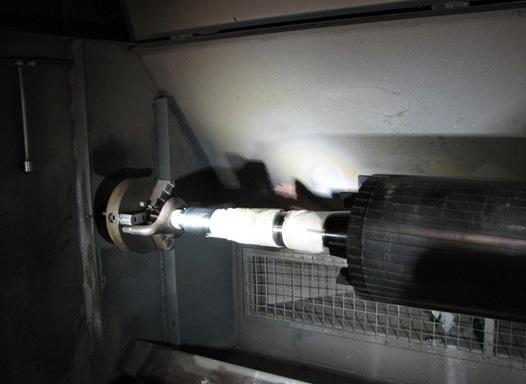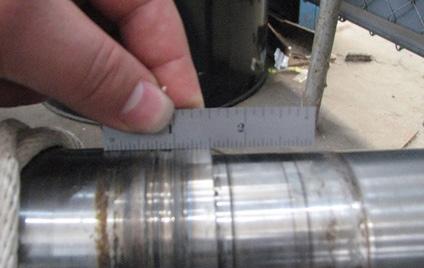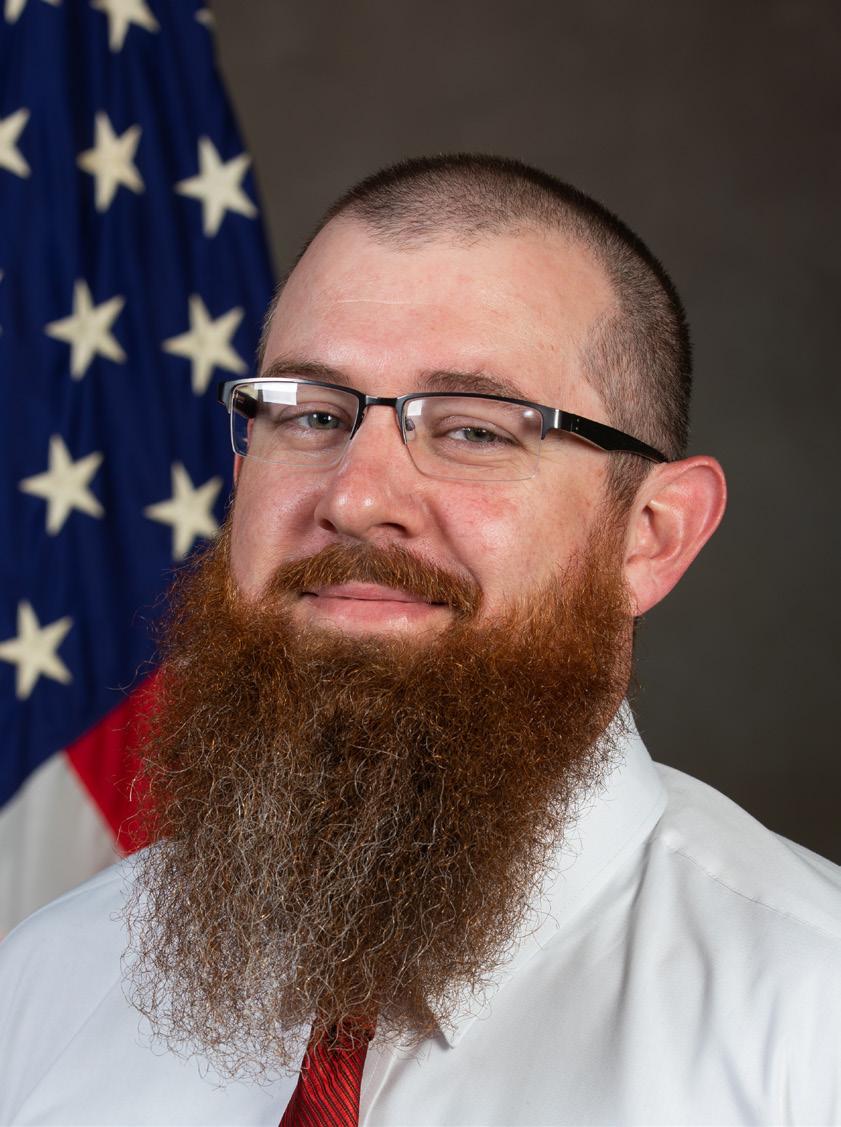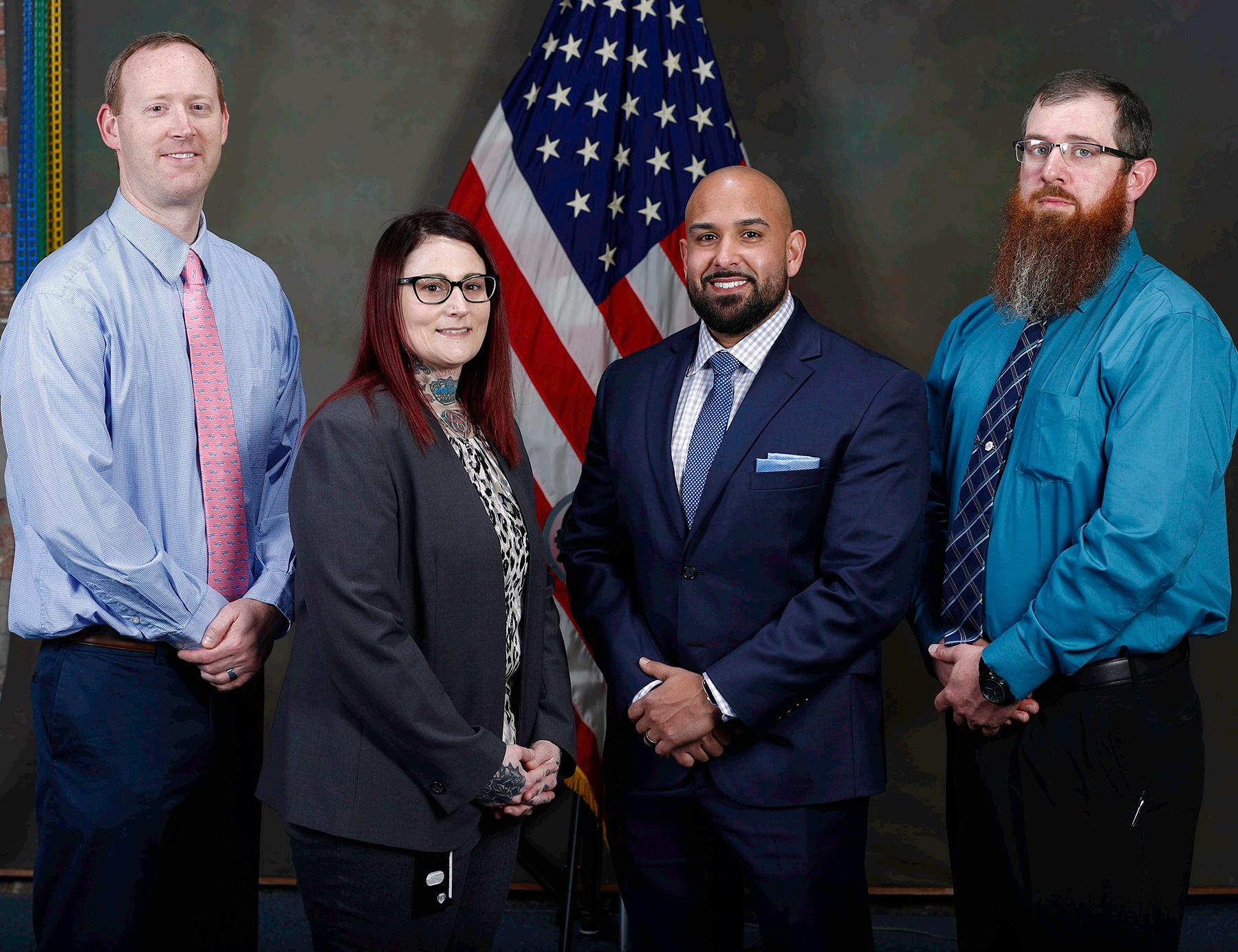
12 minute read
EYE ON INNOVATION


Advertisement

The Norfolk Naval Shipyard Cold Spray Team performed the first organically executed cold spray repair for any U.S. naval shipyard on a component for the USS George H.W. Bush (CVN 77) Project.

COMPLETED AT NNSY
STORY BY KRISTI BRITT • PUBLIC AFFAIRS SPECIALIST
PHOTOS COURTESY OF DAN STANLEY
Norfolk Naval Shipyard (NNSY) had a momentous win in innovation recently, developing and completing the first organic cold spray repair of the U.S. naval shipyards.
USS George H.W. Bush (CVN 77) had a repair opportunity arise in March 2020 after the discovery of damage to a water pump motor shaft. With the shipyard working to balance the mission while fighting the spread of COVID-19, a repair plan began to develop.
The solution: utilize the innovative repair process called cold spray. Cold spray is an additive repair process where the expansion of a compressed and heated gas is used to accelerate metal powder to sufficient velocity to cause the powder to deform and create a mechanical bond upon impact with a base material. The cold spray process occurs at significantly lower temperatures than traditional repair methods such as welding and thermal spray.
In Jan. 2019, America’s Shipyard began the process to retrofit the existing thermal spray booth in Bldg. 163 to support cold spray operations. As the NNSY Cold Spray team neared the final stages of the booth retrofit and towards attempting its first organic cold spray repair, the Bush component was identified and fit the criteria to be cold spray repaired.
“In order to execute this repair with cold spray, we had to utilize the recently published Uniform Industrial Process Instruction (UIPI) for cold spray and prove through a battery of required tests that cold spray would be a valid repair for the specific component,” said Code 265 Submarine Mechanical/Piping Branch Head Daniel Stanley, NNSY Transformation Manager for Cold Spray. “With the cold spray repair plan developed and tests identified, we manufactured and performed the application of cold spray on the necessary test coupons and mockup to support analysis by the Mid-Atlantic Regional Test Laboratory (Code 134). With the necessary testing passing Code 134 analysis and proving cold spray was a viable repair, we then pre-machined the component to support application of cold spray. With the part prepped and mounted within the cold spray booth, NNSY Mechanical Group Code 930 and Code 265 applied the cold spray and subsequently Code 930 did post machining on the part to return it to its final dimension.”
As this was the first cold spray repair performed at the
ABOVE: An emergent repair was needed for a component for the USS George H.W. Bush (CVN 77). BELOW: Final machining took place for the component Apr. 1.


shipyard, there was some initial hesitation to perform this process on the component. Stanley explained that the Bush project was initially hesitant to accept the risk of utilizing a technology which had never before been completed organically at NNSY taking into consideration their overall tight project schedule.
“With the first time execution of this process, as expected, we had encountered a number of situations we had not previously envisioned and gained many lessons learned,” said Stanley. “Even though the UIPI for cold spray was approved by both the shipyard and NAVSEA, this was the first time it was tested/executed in a shipyard environment. As issues arose, the NNSY team was able to leverage relationships with the cold spray team at Puget Sound Naval Shipyard (PSNSY) and Penn State Applied Research Laboratory (PSU ARL) to overcome the barriers encountered and provide ways to better improve our processes for the future.”
Another unexpected challenge was the safety precautions being put in place to combat COVID-19. “It was when we sent the cold spray repair coupons to the Code 134 lab for testing that the first high risk guidance was established at the shipyard,” said Stanley. “This greatly reduced the ability of the lab to complete testing as well as the number of production resources capable of doing the pre-machining for the component, cold spray repair itself, and the post-machining.”
In those times of uncertainty, Stanley and his team sought answers for how to perform the work safely and ensure the mission was upheld. “With the lab aspect complete, the team was able to obtain some assistance from Code 200 and Code 930, providing the necessary personnel to be put in place to support the pre/post-machining of the component. Meanwhile, Code 265 assisted Code 930 with execution of the cold spray application of the component,” said Stanley. Final machining of the component took place Apr. 1. The component is currently being assembled for shipboard use.
“Despite a significant decrease of personnel reporting to work and in the middle of the shipyard ramping up our fight against COVID-19, innovation forged ahead,” said Code 200 Engineering Planning Manager Michael Zydron. “Our shipyard family was able to come together to plan and complete this historic repair – even in the midst of a pandemic. Our team is a great example of excellence – maximizing the mission while minimizing the spread. Thank you to everyone involved!”
“It was a true teamwork experience working with the limited resources at hand,” added Stanley. “This is a huge win for the shipyard and the Cold Spray Community. The repair NNSY performed allowed the team to evaluate its facilities and identify improvements needed for future repairs. For the cold spray community, this repair is a major accomplishment as it shows that our efforts to implement cold spray within NAVSEA and the Department of Defense (DOD) are being successful.”
Stanley continued, “Having a cold spray facility in place at NNSY allows other shipyards and DOD facilities to establish a roadmap in respect to developing their own cold spray capabilities. In contrast to other technologies, cold spray’s primary challenges have been the facilities to support the operation. A running facility at NNSY also gives a conduit for organizations such as Penn State Applied Research Laboratory (ARL) or the Army Research Lab to transition some of their technology from the lab into a real world application.”
Stanley explained that this is only the beginning for cold spray being utilized directly at America’s Shipyard. “The cold spray team at NNSY has spent the last year renovating, upgrading and designing the facilities that are capable of supporting the operation of cold spray, driven mostly by the premise of a technology that would directly result in better repairs,” he said. “In respect to the shipyard, it has required a high-level of support both with funding and assistance in overcoming obstacles to get the facilities where they are today. As a result, we have nitrogen generation capabilities, two large rooms to perform cold spray operations, two robotic arms, a large array of workstations to handle a variety of components, and an exterior work cell with onsite machining capabilities.”
He continued, “In addition to this repair, NNSY recently completed a large cold spray repair for a seawater component from the USS San Francisco (SSN 711) project in support of its undocking. Cold Spray was VADM Thomas Moore’s (Commander, NAVSEA) number one priority for innovation in 2019 and we aim to continue to push the boundaries of how we could use this technology.”
For more information regarding Cold Spray at NNSY, Contact Daniel Stanley at daniel.p.stanley@navy.mil. For more information regarding innovation opportunities at NNSY, contact the NNSY T&I Lab at 757-396-7180 or email the REAL Ideas program at NNSY_ REALIdeas@navy.mil.
Members of the NNSY Cold Spray Team included: Code 930’s Nick Allen, Jim Wiseman, Sean Schuffert, Sterling Slaughter, Rick Smith, Robert Ward, Tim Holland, Richard Griswold; Code 134’s Lenka Ovcina; Code 265’s Kyle Paragian and Stanley; and the Welding and Non-Destructive Test Engineering Department’s (Code 138) Mike Mannix.
ROBERT JARMAN
STORY BY KRISTI BRITT • PUBLIC AFFAIRS SPECIALIST

Code 361 Nuclear Zone Manager Robert Jarman, also affectionately known by many as "Red Beard", has always had Norfolk Naval Shipyard (NNSY) in his veins. His great grandfather, grandfather, and mother all found a calling at NNSY’s waterfront. Therefore, it was no surprise that his journey would also bring him to America’s Shipyard.
In the early days of his career at 17 years old, Jarman was a procedural air traffic controller in the United States Marine Corps (USMC), spending five years on active duty. He was primarily stationed in California but was afforded the opportunity to travel around the world to Okinawa, Japan; South Korea; and Thailand. He completed his contract with the USMC in 2006 and begun working job after job, looking for the next move in his career. At the time, his mother, Peggy Jarman, was working in the Information Technology (IT) Department. “She told me that the shipyard was the way to go,” said Jarman. “I was looking for stability and hoped to find a lasting career so I applied. It took me two years to get my foot in the door; but as soon as I got into the Lifting and Handling Department (Shop 72) as a Rigger Mechanic, I absolutely loved NNSY and I’ve been here for eight years now.”
Jarman continued to progress in his professional journey moving through the ranks of the Lifting and Handling Department (Code 740) making work leader and supervisor, eventually finding himself in Code 361 as a Nuclear Zone Manager. An opportunity came up in the form of the Journey Level Leaders (JLL) Program, a mid-level leadership development program designed to advance the enterprise’s top performers with unique opportunities to practice and expand leadership skills. Interested in applying, Jarman began his application and turned to his department head, Code 361 Project Superintendent Joe Singer.
“Mr. Singer was a past graduate of the Executive Development Program (EDP) and when I came to him, he shared about his experience and told me that the EDP was the way to go if I was looking for more leadership opportunities,” said Jarman. “I decided to change course and apply for the EDP. I worked with Mr. Singer on my application and he mentored me on what I needed to do and how to better myself.”
He was recently selected as one of the four candidates in Cadre 9 of the EDP and is very excited to step outside of his comfort zone and develop his leadership skills for his future and the future of America’s Shipyard.
“There are so many things I want to accomplish with this program,” said Jarman. “I’ve found that I need to work on improving my interpersonal skills so I don’t come across as abrasive or uncompassionate to those I work with. I also need to open myself up to what the rest of the shipyard does as a whole. Like my counterparts within the program, I had always understood fully what my area of expertise does for the shipyard, but anything outside of that I wasn’t sure how it fit into the bigger picture. Being able to go out into the shipyard and visit the various shops and learn firsthand what they do and how they function is huge. I get to see how the shops work both independently and as part of the shipyard family.”
The EDP is a six-month program designed to give qualified personnel the opportunity to experience, first-hand, the leadership competencies and styles, as well as the operational parameters and guidelines, that make up the total picture of successful naval shipyard operations. To learn more about the program, visit https://webcentral.nnsy.navy.mil/ departments/c900/C900CU/leadership%20developement/NNSY%20Executive%20 Developement%20Program.aspx.
Getting to Know Robert "Red Beard" Jarman
Q. What is some advice you’d give to your fellow shipyarders?
A. With hard work and determination, the sky is the limit! If you’re willing to put in time and effort into your job, this is an amazing place to be.
Also, if there’s anything you’re interested in doing, go for it! Apply for as many positions as possible. Try something new! The worst thing that can happen is they tell you no or things don’t work out. There’s nothing wrong with trying to better yourself. It’s up to you to take those steps.
Q. Are there any mentors you’ve had that have played a role in your career?
A. Shop 72 Rigging Trades Manager Colby Wallace played an essential role in helping me understand the lay of the land from a shipyard perspective. He helped me establish myself as a leader within Shop 72.
Code 361 Deputy Project Superintendent John Gordan opened my eyes to how little I knew about the shipyard and was instrumental in pushing me to further develop myself.
I truly appreciate these gentlemen’s efforts and persistence to help me grow and develop both personally and professionally.
Q. Has any changes been made to your program due to Coronavirus-19 (COVID-19)?
A. We have currently halted our shadowing, interviewing, and travel plans due to COVID-19; however, we have been redirected as the singular point for COVID-19
Q. Talk a little bit about your family.
A. Many of us have been part of the shipyard in some way. Even my wife, Karen, is now here as a Shop 51 Apprentice.
My wife and I have been married for 14 years. Together we have two children, Brandon (17) and Rylee (12).
Brandon is attempting to be the fifth generation employed at NNSY. He recently submitted his application to the apprenticeship program and is looking forward to joining the ranks of our shipyard family. Rylee is a horse enthusiast. She dreams of growing up to be an equine veterinarian.
Q. What’s it like outside of work for you?
A. I’m a big-time hunter and am on the executive committee of the Meherrin Bow and Gun Club. I really love being outdoors. I also love to cook and grill. I also enjoy small woodworking projects, even though I’m not very good at it. I really enjoy working with my hands. And I’m a die-hard Minnesota Vikings fan!
I also enjoy raising a garden with my wife and tending to our various animals. Currently we have two dogs, Sweet Pea and Pixie; two cats, Chewbacca and Vader; a rabbit, Queen Wintergreen Jellybean Wolverine; a 150 gallon tank with lots of fish; and six chickens.
The Executive Development Program, or EDP, is an annual program that opens its doors to candidates with a common goal: to learn from senior leadership from across the enterprise.
It's a competitive, corporate program across the four public shipyards. It's open to all NNSY civilians who are at a permanent GS-12 or GS-13 level who've been in their position for at least one year.
Each candidate is given the opportunity to directly mentor under some of the most influential senior leaders within America's Shipyard. In addition, they get to travel to the other public shipyards as well as Naval Sea Systems Command (NAVSEA) Headquarters.
For more information about the program, please contact Danielle Larrew at danielle.larrew@navy. mil.








